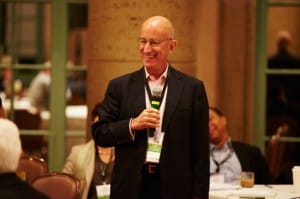Top Story
The CEO Summit is held each year at the ULI Fall Meeting. A limited number of chief executives are invited to discuss the latest industry trends and share their experiences and lessons learned from managing their organizations in the face of global trends, such as changing demographics, emerging technologies, a new regulatory environment and the  complexities of the capital markets. A keynote speaker is invited to set the stage for the day, followed by roundtable conversations about the opportunities and challenges of leading organizations in today’s business climate.
complexities of the capital markets. A keynote speaker is invited to set the stage for the day, followed by roundtable conversations about the opportunities and challenges of leading organizations in today’s business climate.
The third annual CEO Summit, sponsored by the ULI Robert C. Larson Leadership Initiative and Ferguson Partners was held at the 2011 ULI Fall Meeting in Los Angeles. ULI convened a select group of CEOs for three hours of inspiration and discussion on what it will take to lead a real estate firm in the future. This invitation-only event, was limited to 50 CEOs and other heads of real estate–related companies to ensure the productive use of time and deliver excellent take-home value.
The goal was to bring together heads of firms from all over the world both to discuss global issues as they relate to our enterprises and to look outside the industry for best practices as a guide to dealing with the challenges of the C-Suite.
The highly interactive session began with a Elizabeth Stephenson, a partner in McKinsey, led a discussion entitled “Global Forces: The Five Crucibles for Change.” In a power point presentation “What Happens Next?” she described that in the next decade innovation will come from rebalancing the global economy, especially with India and China; a mandate for improved productivity; a global grid that connects the planet; a pricing mechanism that accounts for all resource usage (UPS was able to cut system wide cost by 2% by eliminating left turns by their fleet of trucks) ; and governments as major players and legitimate partners in the global economy. “In this world, the optimists have it,” argues economist David Landes in the closing paragraphs of The Wealth and Poverty of Nations, his brilliant survey of 500 years of economic development. They have it, he adds, “not because they are always right, but because they are positive. Even when wrong, they are positive, and that is the way of achievement, correction, improvement, and success.” The group was then asked to discuss at their roundtables what they were doing regarding innovation.
Hank Nothhaft, CEO of Danger Inc. and a self-proclaimed “serial entrepreneur,” then spoke about the leadership lessons in his new book Great Again. He made an impassioned plea for the creation of more jobs in the United States, noting that it was far easier to create a start up in China than here at home and criticizing the lack of a national strategy for business development. Technical training is a particular challenge as 60% of students return to their home countries. “We’re not producing enough engineers,” he lamented.
One of the highlights of the summit was an challenge to the audience at various intervals during the morning called “Stump the CEO” where each participant submitted a question and another randomly choose one to answer. In response to the question of “how to recruit the best talent” one CEO answered, “Look for those comfortable in chaos.”
GE Capital Real Estate’s Kathleen Carey, a ULI Robert C. Larson Advisory Board member, commented that she was made much more aware of the critical importance of staying current with new technologies, particularly social networking. “Technology gets old quickly,” she said. “If you and your organization are not cutting edge, you’ll miss out and quickly become irrelevant and ignored.”
For Mike Lowe of Lowe Enterprises, “the best part was certainly having the opportunity to debate big picture issues and ideas with peers across the industry.”